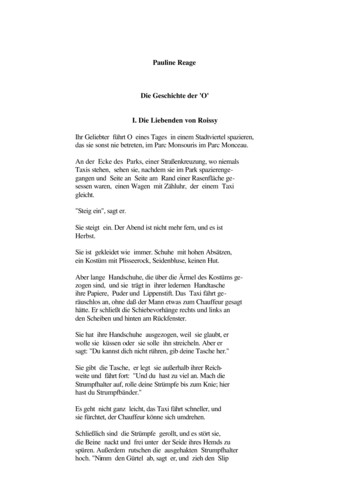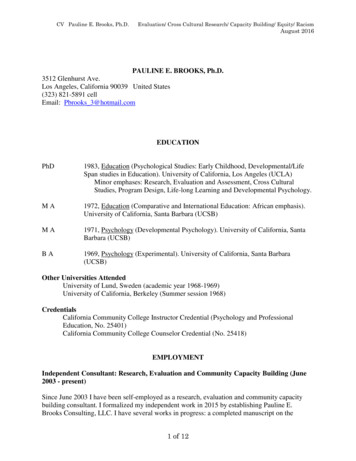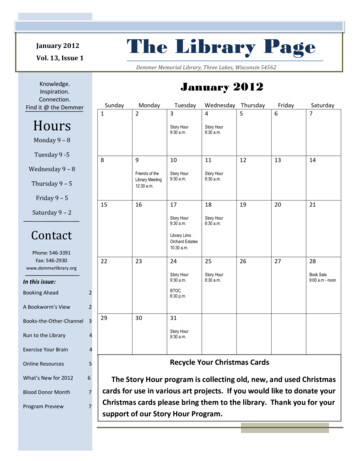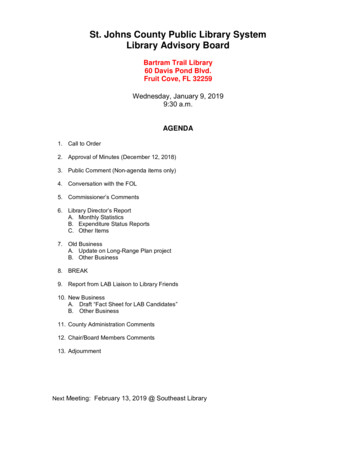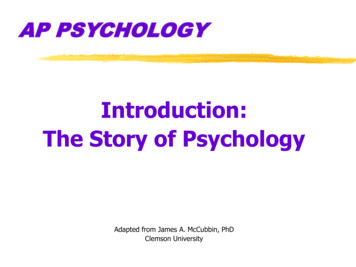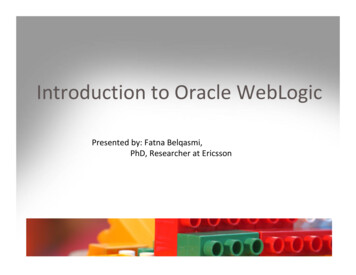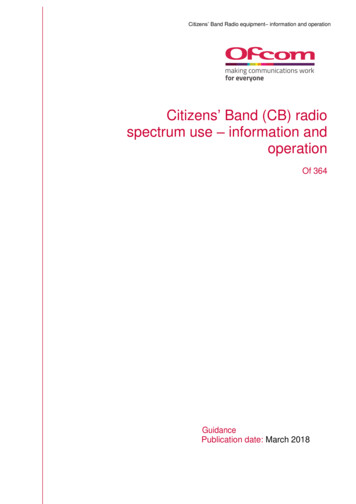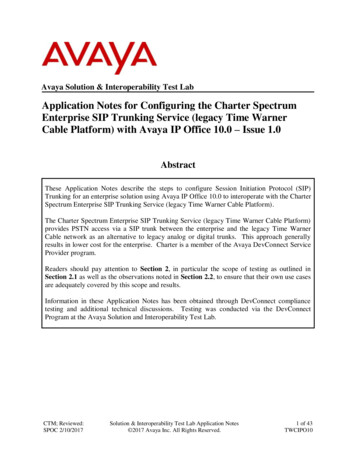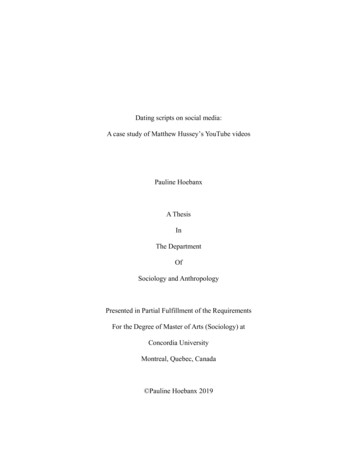
Transcription
Dating scripts on social media:A case study of Matthew Hussey’s YouTube videosPauline HoebanxA ThesisInThe DepartmentOfSociology and AnthropologyPresented in Partial Fulfillment of the RequirementsFor the Degree of Master of Arts (Sociology) atConcordia UniversityMontreal, Quebec, Canada Pauline Hoebanx 2019
CONCORDIA UNIVERSITYSchool of Graduate StudiesThis is to certify that the thesis preparedBy:Pauline HoebanxEntitled:Dating scripts on social media: A case study of Matthew Hussey's YouTube videosand submitted in partial fulfillment of the requirements for the degree ofMaster of Arts (Sociology)complies with the regulations of the University and meets the accepted standards withrespect to originality and quality.Signed by the final examining committee:ChairDr. Amy SwiffenExaminerDr. Julie ArchambaultExaminerDr. Océane JasorThesis Supervisor(s)Dr. Marc LafranceApproved byDr. Amy SwiffenChair of Department or Graduate Program DirectorDeanDateApril 17, 2019
iiiAbstractDating scripts on social media: A case study of Matthew Hussey’s YouTube videosPauline HoebanxHeterosexual dating practices have been studied extensively in the social sciences. Many of thesestudies have employed Simon and Gagnon’s scripting theory (1986) as their theoreticalframework, finding that heterosexual dating norms have not changed since the 1950s (Laner &Ventrone, 2000). Among these studies, some have used dating advice as an empirical source ofdata, though they have remained focused on dating advice in the print media (e.g. Eaton & Rose,2011; Rose & Frieze, 1993). There are no existing studies about dating advice on social media,and the present study proposes to address this gap in the literature, by conducting a qualitativecase study of a sample of 30 videos from dating coach Matthew Hussey’s YouTube channel(Hussey, n.d.). By changing the dynamics of information production, distribution andconsumption, social media has increased the flow of accessible information, and this thesisexamines whether such a transformation has affected norms surrounding dating scripts. Drawingupon Jackson’s four dimensions of the social (2006a), I propose an analysis of the intersectionsof heteronormativity, mononormativity (Barker, Gill, & Harvey, 2018), and neoliberalism inMatthew Hussey’s dating advice videos. This research found that the dating scripts discussed inHussey’s videos are akin to those described in previous studies. However, an unexpected findingof this project was the limitations of scripting theory in accounting for structural power relations.Keywords: dating scripts, scripting theory, heterosexual dating advice, social media, self-help,YouTube
ivAcknowledgmentsDr. Marc Lafrance has provided me with unwavering support, invaluable guidance, andenthusiastic encouragement during this project. His passion and drive for excellence have pushedme to pursue a doctoral degree, and for that I thank him.I would also like to extend my thanks to my committee members, Dr. Julie Archambaultand Dr. Océane Jasor, for their valuable feedback, and for their time.I thank Dr. Martin French, for his help and counsel on this project, as well as for theopportunities he has sent my way.I also thank Chase Ross, creator of the YouTube channel uppercaseCHASE1, forgenerously and patiently answering all my questions about YouTube.To Anne-Marie Turcotte, my self-appointed mentor: thank you for your guidance, yoursupport, and your friendship. My CV has doubled in size since I met you.To my friends John Bryans, Samantha Ilacqua, Salomé Aka, and Circé Ribar: thank youfor your enthusiasm about my project, your love, and for distracting me when the going gottough.To my parents and my sister: I could not have done it without you. Thank you for yourlove and your support.
vTable of ContentsIntroduction . 1Literature Review. 5Dating. 6Dating Scripts. 8Rape Culture and Intimate Partner Violence (IPV) . 12Critical Heterosexuality Studies. 16Neoliberalism . 18Social Media and Mass Media . 20Conclusion . 23Theoretical Framework . 25Scripting Theory . 25Jackson’s Four Dimensions of the Social . 27Context . 31Pick-up Artists and Dating Advice . 32Methodology . 35Description of the Sample . 35Advantages and Limitations of YouTube as a Fieldwork Site . 39Research Design. 41Braun and Clarke’s six phases of thematic analysis (2006, pp.16-23). . 41Visual situational analysis. 44Jackson’s four dimensions of the social as an analytical tool. . 48Results and Discussion . 52The Dimension of Subjectivity . 53Hussey’s representation of himself. . 53The imagined audience. . 57The neoliberal viewer. . 61Summary of findings. 64The Dimension of Routine Social Practices . 65Hussey’s social practices. . 65Hussey’s advice as social practices. . 68Dating advice and the neoliberal subject. . 74Summary of findings. 77The Dimension of Meaning . 79
viHeteronormativity. . 79Mononormativity. . 84The rationalization of emotion and intimacy. . 87Summary of findings. 91The Structural Dimension . 93The institutionalization of the hierarchy of sexualities in Canadian law. . 93Dating scripts and gender inequality. . 95The responsibilization of the neoliberal subject. 98Summary of findings. 100Conclusion . 101References . 108
1IntroductionEvery single one of us wants to make an impact when we're on a date, so hereare five simple things that you can do to stay in his mind long after you'vesaid goodnight. (Matthew Hussey, transcripts, p.92)Matthew Hussey’s YouTube videos made dating seem easy. I first discovered them in2016, when I had just moved from Brussels to Toronto. YouTube had automaticallyrecommended one of his videos to me, and while I do not remember what it was about, I doremember clicking on it, curious to learn more about dating norms on the other side of theAtlantic. I soon started watching Hussey’s videos regularly. They were short, entertaining, andpromised to teach me the “5 First-Date Moves That Make Him Want More,” the “3 Steps toMake Him Commit To You,”, the “5 Dating Hacks that Make Him Fall For You,” and even “TheOnly 2 Answers You Need for Every Dating Problem.” I felt like his videos were teaching me therules of a game I had never properly learned how to play. The advice was familiar: he relied onthe same tropes I had learned growing up from the media and from discussing dating woes withmy friends. For example, in his video “What Makes You Undervalued by Men ”, Hussey says:People need to see us as a challenge. If we come too easily, we will not bevalued. It doesn't matter what your actual value is, don't expect people tovalue it if it comes to them too easy. (Transcripts, p.26)I had always heard I should ‘play hard to get,’ but the advice seemed to make more sensewhen Hussey recommended it; there was a reasoning behind every action and reaction. He madedating seem less like a haphazard art, and more like a strategic game. But something unsettledme about his advice. Watching his videos sometimes made me feel like I was responsible for thedating problems I would face – problems my friends were facing as well. According to Hussey, itwas somehow my fault that men were reluctant to commitment: I was not saying the right things,nor acting in the right way. On a particularly difficult day during my fieldwork, I wrote “This
2feels like I am being scolded. This is triggering bad relationship flashbacks” (Personal notes,Visual analysis, p.10)I felt disillusioned and annoyed by Hussey’s advice. Why was this dating coach puttingthe responsibility of culturally shared dating problems and frustrations on the shoulders ofindividual women? Why was this man teaching women how to make a man commit to them,instead of addressing why they would need to force a man to do so in the first place? Why didwomen need to learn how to make a man fall for them, as if being themselves were not enough?These videos were not just teaching women how to ‘Get the Guy’ (Hussey’scatchphrase), they were telling a story about the expectations placed upon women and men inintimate and romantic settings. Studies focusing on Western 1 heterosexual sex and relationshipadvice books have found that most contemporary advice resembles the advice that was given inthe 1950s, despite subsequent transformations of dating practices, as well as the structuralreorganization of contemporary Western societies (e.g. Eaton & Rose, 2011; Rose & Frieze,1993).However, recent events have brought to light the broader structural pressures underlyingmen and women’s intimate relations, and the prevalence of women’s experiences of genderedviolence and harassment at the hands of men. Founded in 2006 by Tarana Burke to assistsurvivors of sexual violence, the ‘me too’ movement was popularized in 2017, when the nowviral hashtag was used in a series of posts by women on Facebook and Twitter, denouncingsituations of sexual assault and harassment they had experienced (Burke, n.d.; Zacharek,1For the purposes of my study, when I refer to the West, I am referring to Anglo-AmericanWestern countries. pag
Chair of Department or Graduate Program Director . Date . April 17, 2019. Dean. iii . Abstract . Dating scripts on social media: A case study of Matthew Hussey’s YouTube videos . Pauline Hoebanx . Heterosexual dating practices have been studied extensively in the social sciences. Many of these studies have employed Simon and Gagnon’s scripting theory (1986) as their theoretical framework .

